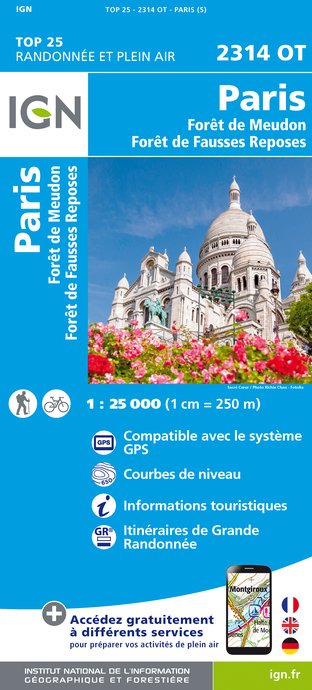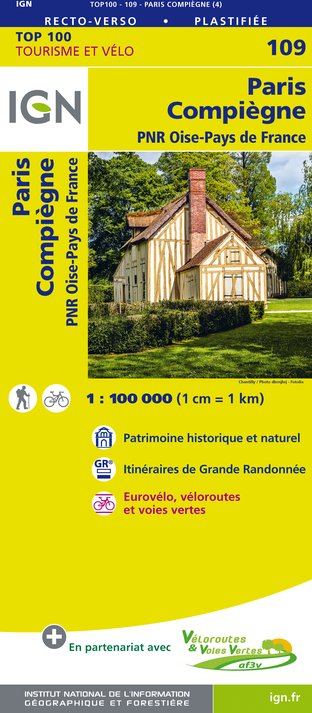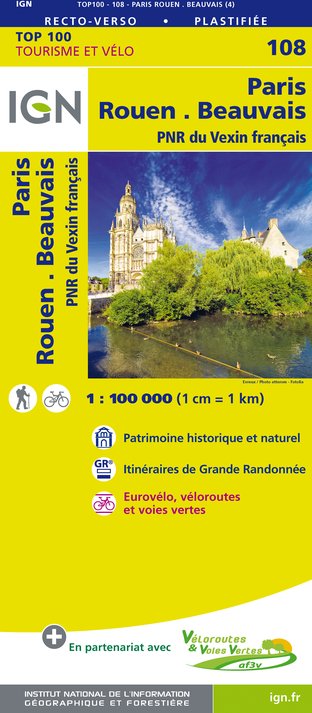Alerta
Alertas
Tipo de práctica
A pie
En bicicleta
Presentación
Mapa
Puntos de interés
Resumen de Cirkwi
Calificaciones y reseñas
Ver alrededor
La desconocida del Sena

Crédito : unbekannt
El resumen de Cirkwi
Descubriendo París: El Camino de la Desconocida Dama del Sena
Propuesto por Balades Fluviales Fabienne Lemoine Fondateur, este itinerario te sumerge en un cuento parisino envuelto en misterio y artismo. La Desconocida Dama del Sena, cuya belleza sin vida inspiró a innumerables artistas y escritores, sirve como una guía inquietante a través de los días pasados de París. Este viaje nos lleva más allá de los lugares comunes para explorar las profundidades del alma de la ciudad. Mientras caminamos en los pasos de la historia parisina, se nos recuerda que la belleza puede surgir de la tragedia, arrojando un atractivo atemporal sobre la Ciudad de la Luz. Este camino único promete una exploración de los relatos menos conocidos de París, susurrados por el río Sena.
Resumen técnico del itinerario
Esta ruta a pie abarca aproximadamente 3,87 km, navegando por elevaciones que van desde los 27 metros hasta un modesto pico de 37 metros. La ascensión y descenso fluctúan ligeramente, presentando un cambio de elevación total de 5-7 metros. Este perfil sugiere un paseo tranquilo adecuado para participantes de todos los niveles de condición física. Dada su distancia relativamente corta y los mínimos cambios de elevación, este itinerario es accesible, permitiendo tiempo suficiente para la contemplación y el descubrimiento sin necesidad de equipo especializado o una preparación física extensa.
Consejos estacionales para los viajeros
Al planear tu visita, ten en cuenta las cambiantes estaciones parisinas. La primavera y el otoño ofrecen temperaturas suaves y menos multitudes, haciéndolos ideales para pasear tranquilamente por los caminos históricos de la ciudad. En verano, la belleza de París es innegable, pero debes estar preparado para multitudes más grandes y un clima más cálido, por lo que es imprescindible mantenerse hidratado y usar protección solar. El invierno tiene su propio encanto, con menos turistas y la posibilidad de ver París cubierto de nieve. Asegúrate de llevar capas y calzado cómodo, ya que el paseo involucra superficies variadas. Independientemente de la estación, siempre verifica el pronóstico del tiempo antes de partir para disfrutar de París en su mejor momento.
París: Una ciudad impregnada de historia
La travesía por París no es solo un paseo; es un viaje a través del tiempo. La ciudad, con raíces profundas en el corazón de la cultura e historia francesa, ofrece una perspectiva única sobre el pasado. París, una ciudad que ha presenciado revoluciones, triunfos y tragedias, invita a los exploradores a adentrarse en su rico tapiz. La importancia histórica de la región se extiende más allá de Francia, influyendo en el arte, la política y la cultura a nivel mundial. Este itinerario eleva la historia de una mujer desconocida a un símbolo del misterio y la belleza duradera de París, mostrando la capacidad de la ciudad de cautivar la imaginación a lo largo de los siglos.
Información climática para los viajeros a París
El clima en París se caracteriza por ser templado y algo impredecible. Los inviernos son frescos, con heladas ocasionales y raras nevadas, mientras que los veranos pueden ser cálidos pero no excesivamente, ofreciendo un ambiente cómodo para explorar. Los mejores momentos para visitar son típicamente a finales de primavera (mayo a junio) o principios de otoño (septiembre a octubre), cuando el clima es agradablemente suave y los jardines de la ciudad están en plena floración o majestuosamente transformados. Estas estaciones prometen un magnífico telón de fondo para seguir los pasos de la enigmática Desconocida Dama del Sena, con menos interrupciones por lluvia y un clima moderado que mejora la experiencia general.
Propuesto por Balades Fluviales Fabienne Lemoine Fondateur, este itinerario te sumerge en un cuento parisino envuelto en misterio y artismo. La Desconocida Dama del Sena, cuya belleza sin vida inspiró a innumerables artistas y escritores, sirve como una guía inquietante a través de los días pasados de París. Este viaje nos lleva más allá de los lugares comunes para explorar las profundidades del alma de la ciudad. Mientras caminamos en los pasos de la historia parisina, se nos recuerda que la belleza puede surgir de la tragedia, arrojando un atractivo atemporal sobre la Ciudad de la Luz. Este camino único promete una exploración de los relatos menos conocidos de París, susurrados por el río Sena.
Resumen técnico del itinerario
Esta ruta a pie abarca aproximadamente 3,87 km, navegando por elevaciones que van desde los 27 metros hasta un modesto pico de 37 metros. La ascensión y descenso fluctúan ligeramente, presentando un cambio de elevación total de 5-7 metros. Este perfil sugiere un paseo tranquilo adecuado para participantes de todos los niveles de condición física. Dada su distancia relativamente corta y los mínimos cambios de elevación, este itinerario es accesible, permitiendo tiempo suficiente para la contemplación y el descubrimiento sin necesidad de equipo especializado o una preparación física extensa.
Consejos estacionales para los viajeros
Al planear tu visita, ten en cuenta las cambiantes estaciones parisinas. La primavera y el otoño ofrecen temperaturas suaves y menos multitudes, haciéndolos ideales para pasear tranquilamente por los caminos históricos de la ciudad. En verano, la belleza de París es innegable, pero debes estar preparado para multitudes más grandes y un clima más cálido, por lo que es imprescindible mantenerse hidratado y usar protección solar. El invierno tiene su propio encanto, con menos turistas y la posibilidad de ver París cubierto de nieve. Asegúrate de llevar capas y calzado cómodo, ya que el paseo involucra superficies variadas. Independientemente de la estación, siempre verifica el pronóstico del tiempo antes de partir para disfrutar de París en su mejor momento.
París: Una ciudad impregnada de historia
La travesía por París no es solo un paseo; es un viaje a través del tiempo. La ciudad, con raíces profundas en el corazón de la cultura e historia francesa, ofrece una perspectiva única sobre el pasado. París, una ciudad que ha presenciado revoluciones, triunfos y tragedias, invita a los exploradores a adentrarse en su rico tapiz. La importancia histórica de la región se extiende más allá de Francia, influyendo en el arte, la política y la cultura a nivel mundial. Este itinerario eleva la historia de una mujer desconocida a un símbolo del misterio y la belleza duradera de París, mostrando la capacidad de la ciudad de cautivar la imaginación a lo largo de los siglos.
Información climática para los viajeros a París
El clima en París se caracteriza por ser templado y algo impredecible. Los inviernos son frescos, con heladas ocasionales y raras nevadas, mientras que los veranos pueden ser cálidos pero no excesivamente, ofreciendo un ambiente cómodo para explorar. Los mejores momentos para visitar son típicamente a finales de primavera (mayo a junio) o principios de otoño (septiembre a octubre), cuando el clima es agradablemente suave y los jardines de la ciudad están en plena floración o majestuosamente transformados. Estas estaciones prometen un magnífico telón de fondo para seguir los pasos de la enigmática Desconocida Dama del Sena, con menos interrupciones por lluvia y un clima moderado que mejora la experiencia general.
Generado automáticamente.
IGN tarjetas

2314OT - PARIS FORÊT DE MEUDON FORÊT DE FAUSSES REPOSES
Editora : IGN
Recopilación : TOP 25 ET SÉRIE BLEUE
Escalera : 1:25 000
13.90€

119 PARIS SENS PNR DU GÂTINAIS FRANÇAIS
Editora : IGN
Recopilación : TOP 100
Escalera : 1:100 000
8.40€

190 PARIS CHANTILLY FONTAINEBLEAU
Editora : IGN
Recopilación : TOP 100
Escalera : 1:100 000
8.40€

118 PARIS CHARTRES PNR DE LA HAUTE VALLÉE DE CHEVREUSE
Editora : IGN
Recopilación : TOP 100
Escalera : 1:100 000
8.40€

109 PARIS COMPIÈGNE PNR OISE-PAYS DE FRANCE
Editora : IGN
Recopilación : TOP 100
Escalera : 1:100 000
8.40€

108 PARIS ROUEN BEAUVAIS PNR DU VEXIN FRANÇAIS
Editora : IGN
Recopilación : TOP 100
Escalera : 1:100 000
8.40€

D75-95 ÎLE-DE-FRANCE OUEST
Editora : IGN
Recopilación : CARTES DÉPARTEMENTALES IGN
Escalera : 1:150 000
5.90€

D77 SEINE-ET-MARNE
Editora : IGN
Recopilación : CARTES DÉPARTEMENTALES IGN
Escalera : 1:150 000
5.90€

NR08 CENTRE-VAL DE LOIRE
Editora : IGN
Recopilación : CARTES RÉGIONALES IGN
Escalera : 1:250 000
6.80€

NR03 ÍLE DE FRANCE
Editora : IGN
Recopilación : CARTES RÉGIONALES IGN
Escalera : 1:250 000
6.80€

NR01 HAUTS-DE-FRANCE
Editora : IGN
Recopilación : CARTES RÉGIONALES IGN
Escalera : 1:250 000
6.80€

801 FRANCE NORD OUEST
Editora : IGN
Recopilación : CARTES NATIONALES IGN
Escalera : 1:320 000
6.10€

EUROPE
Editora : IGN
Recopilación : DÉCOUVERTE DES PAYS DU MONDE IGN
Escalera : 1:2 500 000
7.00€
Informaciónes técnicas
A pie
Dificultad
No especificada
Dist.
3.9 km
Tipo de práctica
A pie
En bicicleta
Mostrar más
Perfil altimétrico
Punto de partida
75002
Paris
Lat : 48.86835Lng : 2.35194
Puntos de interés
Autor de los datos
Calificaciones y reseñas
Para ver alrededor




